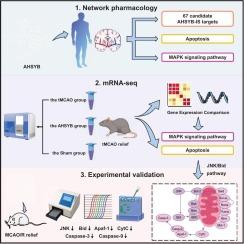结合计算机和实验方法揭示无水红花黄B通过JNK/Bid通路在缺血性脑卒中中的抗凋亡作用
IF 2.6
4区 医学
Q3 NEUROSCIENCES
引用次数: 0
摘要
背景和目的:缺血性脑卒中(IS)是世界范围内死亡和残疾的主要原因。无水红花黄B (AHSYB)具有神经保护作用。本研究旨在探讨其治疗机制,重点关注线粒体凋亡JNK/Bid通路。方法:采用网络药理学方法预测AHSYB-IS候选靶点。利用GO/KEGG富集分析探讨了这些靶点在生物过程和信号通路中的潜在作用。建立tMCAO模型,通过mRNA测序鉴定差异表达基因(deg),重点关注AHSYB拯救的基因。通过基因集富集分析(GSEA)探索AHSYB治疗作用的潜在信号通路。通过分子对接来评价AHSYB与凋亡级联的结合亲和力。最后,MCAO/R模型实验证实了AHSYB对JNK/Bid通路的影响。结果:共鉴定出67个候选靶点,在MAPK信号通路和凋亡等途径中富集。PPI网络显示,BCL2、CASP3、MAPK8等基因度较高。进一步的mRNA-seq分析显示,AHSYB处理的tMCAO小鼠的获救基因在凋亡信号通路和KEGG信号通路(包括MAPK信号通路)调控等生物学过程中富集。最终,基于其在JNK介导的线粒体凋亡中的作用,我们选择JNK/Bid通路进行进一步的分子对接和实验验证。AHSYB与该通路中的关键蛋白表现出显著的结合亲和力,分子结合能为 -1。体内实验表明,AHSYB显著改善神经功能(p )。结论:AHSYB通过抑制JNK/Bid通路关键靶点,阻断线粒体凋亡,具有神经保护作用。本文章由计算机程序翻译,如有差异,请以英文原文为准。

Integrating in silico and experimental approaches to uncover the anti-apoptotic effects of anhydrosafflor yellow B via JNK/Bid pathway in ischemic stroke
Background and Objective
Ischemic stroke (IS) is a major cause of death and disability worldwide. Anhydrosafflor yellow B (AHSYB) has shown neuroprotective potential. This study aimed to investigate its therapeutic mechanisms, focusing on the mitochondrial apoptotic JNK/Bid pathway.
Methods
Network pharmacology was employed to predict candidate AHSYB-IS targets. The potential roles of these targets in biological processes and signaling pathways were explored using GO/KEGG enrichment analysis. A tMCAO model was established, followed by mRNA sequencing to identify differentially expressed genes (DEGs), with special attention given to genes rescued by AHSYB. Gene set enrichment analysis (GSEA) was performed to explore potential signaling pathways involved in AHSYB’s therapeutic effects. Molecular docking was conducted to evaluate the binding affinity of AHSYB with the apoptotic cascade. Finally, an MCAO/R model experimentally confirmed AHSYB’s influence on the JNK/Bid pathway.
Results
A total of 67 candidate targets were identified, with enrichment in pathways such as the MAPK signaling pathway and apoptosis. The PPI network showed that genes such as BCL2, CASP3, and MAPK8 had higher degrees. Further mRNA-seq analysis revealed that the rescued genes in tMCAO mice treated with AHSYB were enriched in biological processes such as the regulation of apoptotic signaling pathway, and KEGG pathways, including the MAPK signaling pathway. Ultimately, based on its role in JNK-mediated mitochondrial apoptosis, the JNK/Bid pathway was selected for further molecular docking and experimental validation. AHSYB showed a significant binding affinity with critical proteins in this pathway, with molecular binding energy < -5 kcal·mol−1. In vivo experiments demonstrated that AHSYB significantly improved neurological function (p < 0.01), reduced cerebral infarct volume (p < 0.01), and reduced the mRNA and protein levels of key genes in the JNK/Bid pathway in both serum and brain tissue (p < 0.01 or p < 0.05).
Conclusion
AHSYB offers neuroprotection by blocking mitochondrial apoptosis through the inhibition of key targets in the JNK/Bid pathway.
求助全文
通过发布文献求助,成功后即可免费获取论文全文。
去求助
来源期刊

Brain Research
医学-神经科学
CiteScore
5.90
自引率
3.40%
发文量
268
审稿时长
47 days
期刊介绍:
An international multidisciplinary journal devoted to fundamental research in the brain sciences.
Brain Research publishes papers reporting interdisciplinary investigations of nervous system structure and function that are of general interest to the international community of neuroscientists. As is evident from the journals name, its scope is broad, ranging from cellular and molecular studies through systems neuroscience, cognition and disease. Invited reviews are also published; suggestions for and inquiries about potential reviews are welcomed.
With the appearance of the final issue of the 2011 subscription, Vol. 67/1-2 (24 June 2011), Brain Research Reviews has ceased publication as a distinct journal separate from Brain Research. Review articles accepted for Brain Research are now published in that journal.
 求助内容:
求助内容: 应助结果提醒方式:
应助结果提醒方式:


